
Ned Pelger's blog on construction, design and other weirdness. Email him at ned@constructionknowledge.net
Please help him win his readership competition against his son Lex at the Construction Phone Apps Blog
The end of a year provides the opportunity to take stock, to contemplate what happened compared to what you hoped would happen. To think on a grand scale, not just about the pesky subcontractor du jour who’s driving you crazy.
So, tell me one valuable thing you learned in 2008? Just jot it down in the comments section. I get about 1000 readers a month, I’m hoping some of you learned something and have the gumption to share it.
As for me, I’d say I’ve been re-learning a saying Dan Harmon, construction superintendent taught me 15 years ago, “Don’t get mad at your money.” Challenging project owners, especially those who delay making decisions as long as possible and then some, are still the project owners. We work because they spend and I need to keep that at the forefront of my petty little efficient mind.
Hoping you a Happy New Year.
The march toward real innovation in sustainable design seems slow. Lots of folks copying dim ideas like roof gardens, but few creative approaches that try new concepts. Of course, good design to minimize heat loss, maximize effieciency and provide lots of outside air (Build Tight, Ventilate Right) continues to make sense, but the innovation of big new ideas seems small.
Along those lines, architectural lighting of buildings has always plagued me. The aesthetic value soars, but so do the energy costs. If the owner turns off the lights to save energy, heh, “We’re in the dark here.” I saw some gorgeous, yet efficient bridge lighting that got me thinking.
This article on nine unique bridges highlights the beautiful X shaped cable stayed bridge with two crossed lanes recently completed in San Paulo, Brazil. While greatly improving traffic flow in the city, the graceful towers and cables add a remarkable design element.
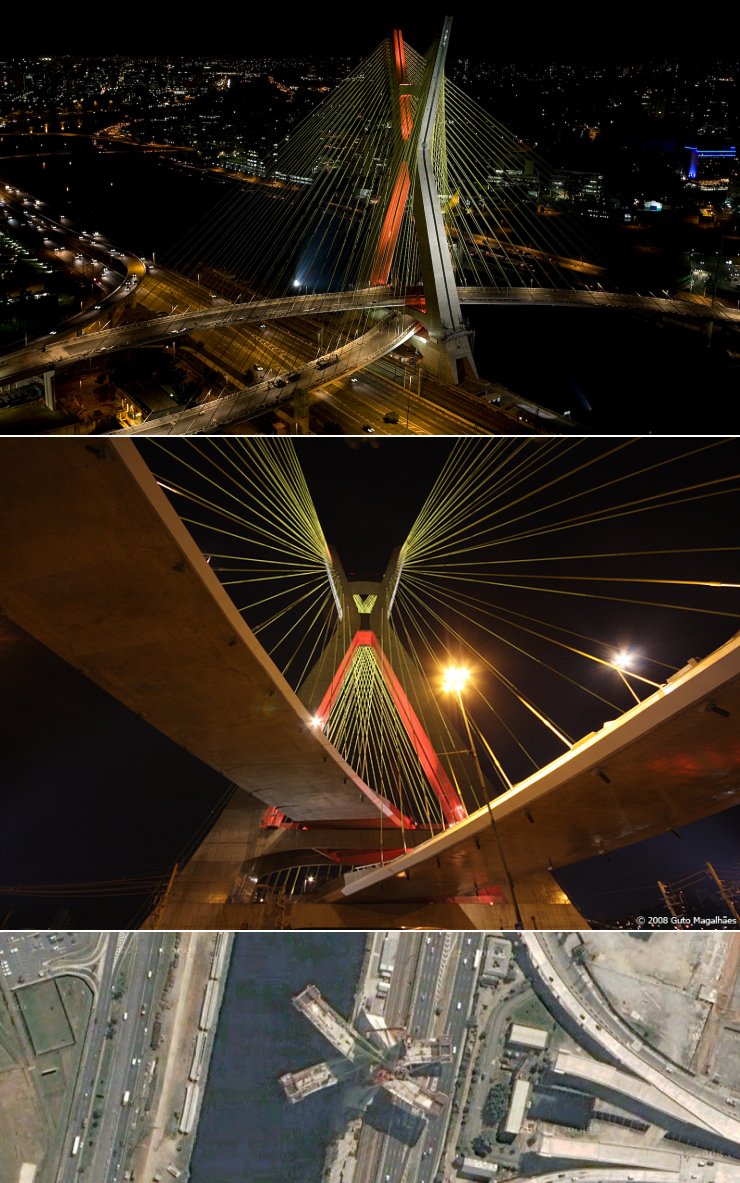
Yet the daytime beauty pales compared to the night view of this marvelous structure. By utilizing an intelligent LED lighting system for architectural lighting, the long term operational and maintenance costs greatly reduce. The video below illustrates (with a cool song as well).
[youtube=http://www.youtube.com/watch?v=-JWa83vzBBE&eurl=http://deputy-dog.com/2008/08/9-amazingly-unique-bridges-you-may-not.html&feature=player_embedded]
The LED lighting system gets further described in LEDs Magazine. I challenge you to think creatively about how the projects you work on can be done in a more sustainable manner. To get your mind moving in that direction, these LEED guidelines are free and help you understand the basics quickly. I encourage you to download the LEED checklists for the type project you’re working on. Review the items and determine if you could suggest any sustainable improvements to your current project.
Remember, Learning Leads to Advancement…and it’s fun to surprise people and make them re-think their assumptions about you.
Dereck was right and I was wrong. There, I’ve said it and settled my bet with Construction Supervisor Dereck Hench about a recent fiasco. We had several sprinkler pipes freeze, break and leak on an apartment project with this recent cold weather. As Dereck and I and several others evaluated the installation and tried to understand what we need to change, I mentioned that pipes don’t break when they freeze, but when they thaw and expand.
Dereck told me that pipes burst when they freeze. I patiently explained that everything contracts with cold and expands with heat. Dereck asked why a gallon jug in the freezer expands and blows out the sides of the container? I knew that phenomena was true, but couldn’t think of an explanation for how it fit into my theory.
Abner, an Amish carpenter who works for Dereck agreed with me, so we both took turns abusing Dereck for being so confident and so wrong. When Dereck told Abner he’d buy him lunch for a week if Dereck was wrong, I started to lose my sureness.
And sure enough, a quick internet search teaches me that water uniquely expands when it freezes. The water molecules line up differently as the water freezes and have more open space between, creating a volume increase of about 9%. Dereck was right and I was wrong.
So what was our sprinkler pipe problem? We needed to have a dry pendent sprinkler head poking out onto the balcony which creates a challenging situation (breaking the basic rule of keeping water lines away from exterior walls). We determined that the insulation needs to be done extremely carefully in this area and not be allowed to be moved prior to drywall. Our exact fix will involve spaying expanded foam insulation on the sprinkler pipe in the exterior wall to guarantee that the insulation remains exactly where we need it.
Weburbanist.com consistently delivers cool articles that are visually stunning. The stairs shown below are just a few of the ones that really stood out to me. When building commercial and industrial buildings, the building code tends to make stairs functional and boring. The stairs shown here seem to mostly come from residential spaces, where more creativity can be practiced.
Swedish TAF Architects designed these efficient stairs for a tight spot utilizing inexpensive pine boxes. Based on the premise of a ship’s ladder, the rise and run gains elevation quickly. It’s also beautiful.
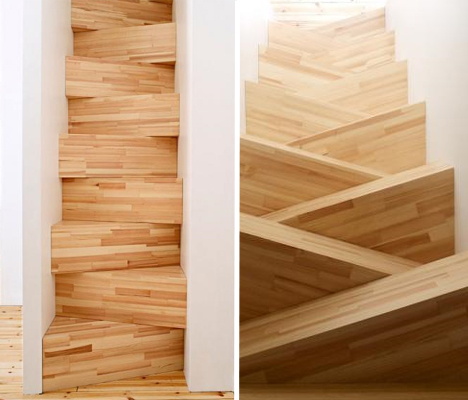
I love the combination bookshelf and staircase shown below. As a passionate reader and book collector, I’m always trying to find new and better ways to store and showcase books. I don’t think I’ve ever seen a more marvelous solution than the one shown below.
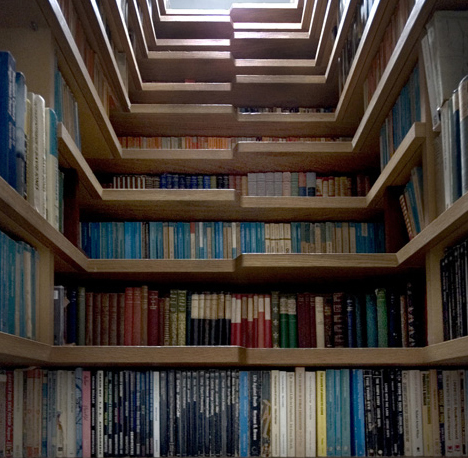
Can you guess how the stairs below are built? Maybe start with what material would likely be used? What cantilevers well and doesn’t deflect too much? Steel. The builders buried a steel beam in the wall on the same angle as the stairs and used full welds to connect the treads.
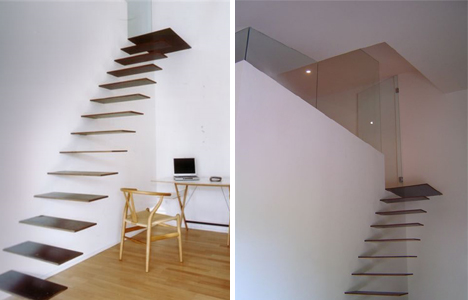
Finally, my favorite stairs just looks like fun.
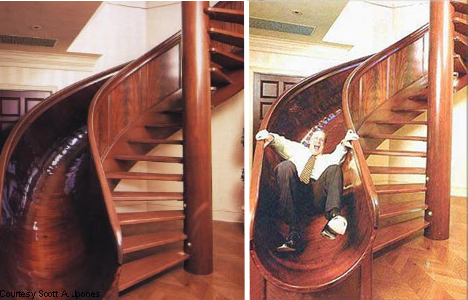
Seeing that final stair reminds me that I need to work out the details on a similar concept for a large church addition I’m on. We will have two slides that let elementary age kids enter their Sunday School rooms by sliding 14′ (from the floor above) down a helix shaped tube. So I get to have some fun too.
Like most people working in construction, I love tools and equipment. Whether it’s a backhoe operator digging efficiently for footings or a trim carpenter using a power miter saw to install crown molding, I enjoy experiencing the results of the right tool in skilled hands.
I often talk about expanding your technical and people skills like trades people expand their toolboxes. But today I’m just thinking about the real tools. The photo below shows the tool cabinet of a piano tuner named Studley.
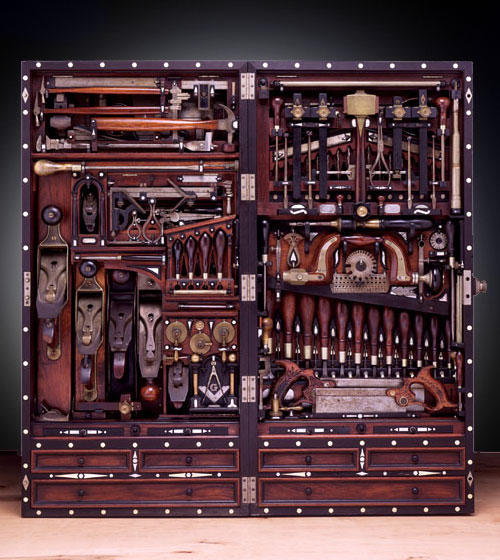
Isn’t that a thing of beauty? Can you imagine working everyday and opening that tool chest to find the exact tool you need? Would you agree it’s a different feeling than reaching into a plastic drywall bucket for your mess of tools?
While most men will smirk at this idea, I’m a fan of surrounding myself with beauty and order. Life goes by fast, I like the idea of pleasant places to work and live. Most job trailers are completely utilitarian, with not a single piece of personality or visual beauty. If you have to work in a space, why not make it appeal to you? Why not add some flourishes that bring you a bit of joy every time you look at them? Maybe even some odd tools on the wall? Do you do this or know anyone that does?
I’ve read that construction projects in China start and end with a bang. Tradition requires that the evil spirits be frightened from the site by setting off a bunch of firecrackers at the start of a construction project, then again when the building is ready to be occupied.
I like that tradition and may suggest it to some of my clients…probably not the big church project I’m currently working on.
Do you have any traditions or superstitions that you start or end projects with? Post a comment if you do.